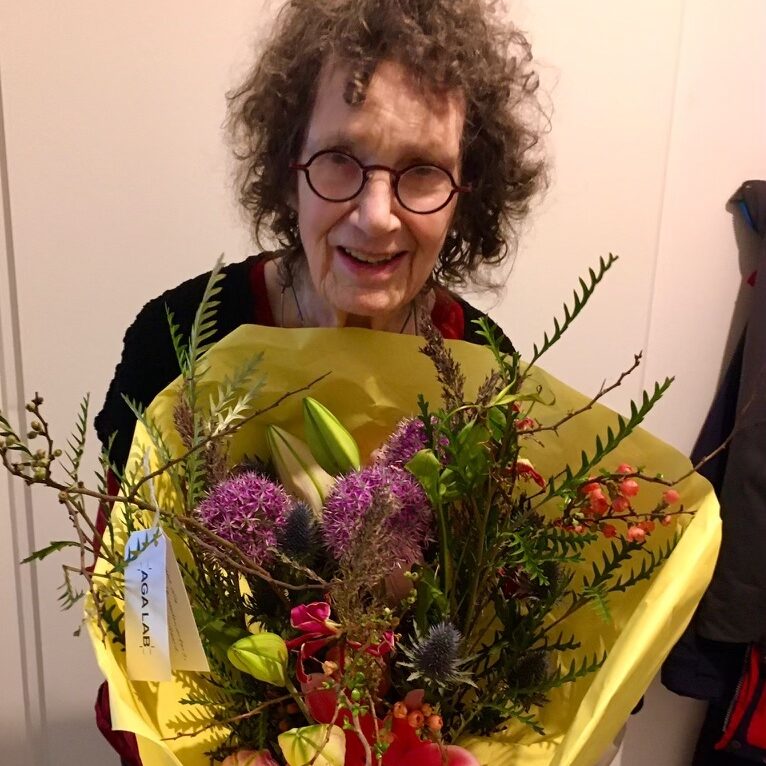Naan beams. The garden at the AGA LAB on the ‘De Roos van Dekamaweg’ is her true love. She wants to know all about how it was when we visited it. She was there herself not so long ago.
“There’s a pear tree, I planted it at the time so that you need less… other materials to achieve a deeper colour. It’s quite a light pigment by itself. But I don’t know if the tree is still budding. Did you look?”
We had seen the tree, but did not pay attention to the buds when we were there. Naan reminisces about how she started the garden when she was a young student. She had bought the pear tree at the Hortus Botanicus in Amsterdam and carried it to the AGA LAB on the back of her bike.
“There was a company driving around the neighbourhood, making holes in the ground. I asked if they could take a few samples of the earth under the concrete, to see if the earth was usable. To do that, they had to [use heavy machinery to] drill three holes in the asphalt. Instead of covering these holes up again, I planted trees in them.”
Naan had first studied biology, and transitioned to making art early on in her life.
“I saw through what I was doing. And I saw it on time. I didn’t want to be part of that anymore.”
But Naan did not abandon her scientific background. On the contrary. When we ask her if she took anything from it into her artistic practice, she responds by immediately getting up and walking to the easel behind the table:
“Do you see what these are? They are drawings, etchings I think, of budding stages of an oak. The buds are very small, so the drawings are enlarged. Growing an oak tree is very complicated… If you want to get a broader understanding of it, you have to go deep.”
This scientific background shines through in the way she speaks about painting with plants. For example, when explaining why she turned away from synthetic pigments she says: “Dat is een aflopende reactie”. This is the Dutch term for chemical reactions that continue until one of the reactants (or all reactants) are depleted. As we understand it, Naan uses this term to differentiate between extractive from regenerative processes of pigment making. Whereby extractive processes frame our environment as a set of “resources”, and take these resources for granted.
Lessons for Local Color
Reflecting on the life and work of Naan, we note two important themes that are relevant for the Local Color project. First, the way she relates to plants and other living organisms, and second the immense background of habits, practicalities, sensitivities and care that are necessary to sustain artistic practice together with living organisms.
Naan made the decision to use exclusively plant-based pigments early on in her career. And although this material choice is very characteristic of her work, she is also very clear that working with plants requires a different attitude and different methods. We cannot simply replace synthetic pigments with plant-based pigments and call it a day. We also need to change our ways of working with and relating to plants. Naan warns us that you can ‘use’ plants, but you can also ‘abuse’ them. But beyond this, we can be inspired by the way Naan has let plants transform her life and art. Naan cares deeply about the garden at AGA LAB. She spent decades tending to it. And because Naan uses pigments that were cultivated from it, her paintings, the colors and shades are all a result of this process of care and attention. Before the violet-brown color in the painting on the Northern wall, there was a harvest of pears. Before the pears, a tree. Before the tree, a seedling. She has been with these colors. Nurtured them. Her paintings carry the garden through them. We take it that this attitude is a result from a very close and embodied relationship with the plants she was growing:
“When you make pigment from plants and you try things out and tinker, you get dirty hands.”
Naan’s work cannot be reduced to her paintings made with plant-dyes. Her method, in which she refuses to disentangle colors from their sources is part and parcel of it. If we take the same approach in Local Color, we are sure to be confronted with similar troubles Naan has faced. The troubles of making land available for dye plants, and unavailable for other things. Tending to some plants and ignoring others. Making habitats and taking them away.
When we first contacted Naan, we were incredibly excited to speak with her. She is, after all, such a revered expert on plant dyes. What secrets could she share with us? What recipes does she have? What plants have we been missing out on? After our conversation, we realized that these questions were a little naive. Her secrets and recipes took years to accumulate, and it is not possible to just ‘transmit’ the art of noticing that she has so keenly developed in one interview. Naan’s artistic practice is much larger than that. To keep it alive, the garden needs to be kept alive. Her habits need to be kept alive. Thankfully, the AGA LAB is taking this seriously and has appointed several apprentices to continue Naan’s legacy and maintain the garden.
Naan is not the first person to use plant dyes. This practice is an ancient one. At the same time, for Naan, dyeing with plants never gets old. Her attitude of wonder allows her to approach plants with fresh astonishment each time. Reflecting on Naan’s work we can appreciate the Local Project project as a wave within a much broader and older movement of nurturing plant dyes, while letting this history transform our current and future ways of doing things.
